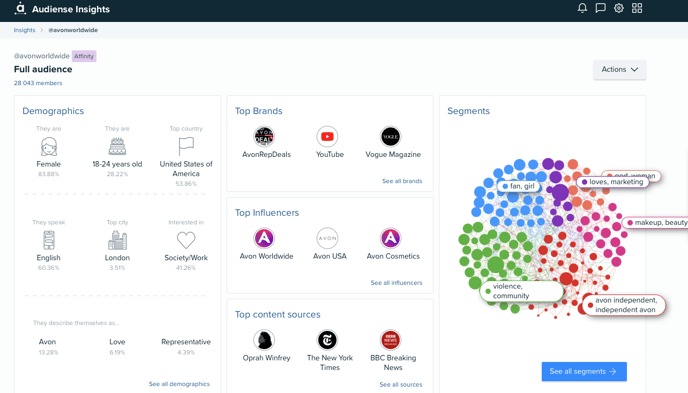Learn about the insights summary view, what each summary means and how you can use each insight...
This summary view is the initial dashboard that you will see when you select your report. You will see a summary of the full audience broken down into the following panels:
- Demographics summary
- How they describe themselves
- Top Brands
- Top Influencers
- Top content sources
- Segments (see all segments)
Demographic summary:
This summary shows the top demographic traits for your audience. For example, a country could be influential in targeting certain groups of people or a popular language could change the language of your ads entirely.
How they describe themselves:
This summary shows the top words used by your audience to describe themselves. Use this to understand what your audience does and how they identify themselves. For example, are the bloggers? Or do they love music? Maybe they are football fans? Use this to get into the mindset of your audience and create more targeted content.
Top Brands:
This summary shows your audience’s favourite brands! Many have used this to understand potential brand partners, such as a musician or a sports team. Brands have found this a useful way to understand competitors in their markets and to really understand the key players that influence the audience. By clicking on this section it takes you to the Influencers & Brands tab, filtered by brands, where you can add more category filters to narrow your search.
Top Influencers:
This summary shows the top (macro) influencers for your audience. We define influencers in two different ways; Macro and Micro Influencers. Below, we outline some benefits and examples of both and when to us these!
Macro influencers: These are the high profile people, often celebrities with a huge reach (>100K followers).
Major industry figures and celebrities have spearheaded some of the most iconic advertising campaigns of all time. The right connection, such as the one between Michael Jordan and Nike, will reward the brand with a lifelong association with a popular figure that drives sales for decades. It’s an ideal situation when it works.
On the flip side, access to the audiences of these bigger names doesn’t come cheap. A single sponsored Tweet from someone like Cristiano Ronaldo has been reported to cost a shade under €250,000. There’s a risk that the delivery of the message (or the message itself) may fail to connect. This highlights the importance of researching the audience of your potential influencers to identify who is engaging with them, and if your audience has a significant crossover with whom you want to be targeting.
If the celebrity is particularly renowned for their sponsorships and advertising deals, a lot of people may not take too much notice of the celebrity selling another product, or they may not completely trust the message being delivered.
Micro-influencers: Often fewer followers (<100K followers), these people are often more specific to an industry (they could be industry experts).
These generally wouldn’t be celebrities, but would have a significant following in the audience you wish to target.
What they lack in millions of followers, they typically make up for in entrenched credibility with the audience you want to reach. This allows them to bring your brand into the conversation at a level that’s personally connected to a lot of people in the audience, this is something that a celebrity or a brand account may be unable to do. As an example, PUMA used popular and socially active local runners in their #IGNITEYourCity campaign a few years back. The influencers they chose recorded engagement rates 24 times higher with their campaign Tweets than the ones PUMA’s core accounts did. This gives PUMA eyes on their campaign in the short term, and a new engaged audience to target in the longer term.
Top content sources:
This summary shows the most popular media outlets for your audience. Use this to help decide where to place your adverts or publish your sponsored contents
Segments:
Understand the breakdown of your audience into unique segments based on either their connection to each other, or similar accounts they follow, depending on the segmentation type selected at the time of creating your report (Interconnectivity or Affinity).
Discover these segment summaries through the segment cards on the next page by clicking on the 'See all segments' blue button below the graph.
For more information about segmentation types, you can learn more via this link, Audiense Segmentation.
